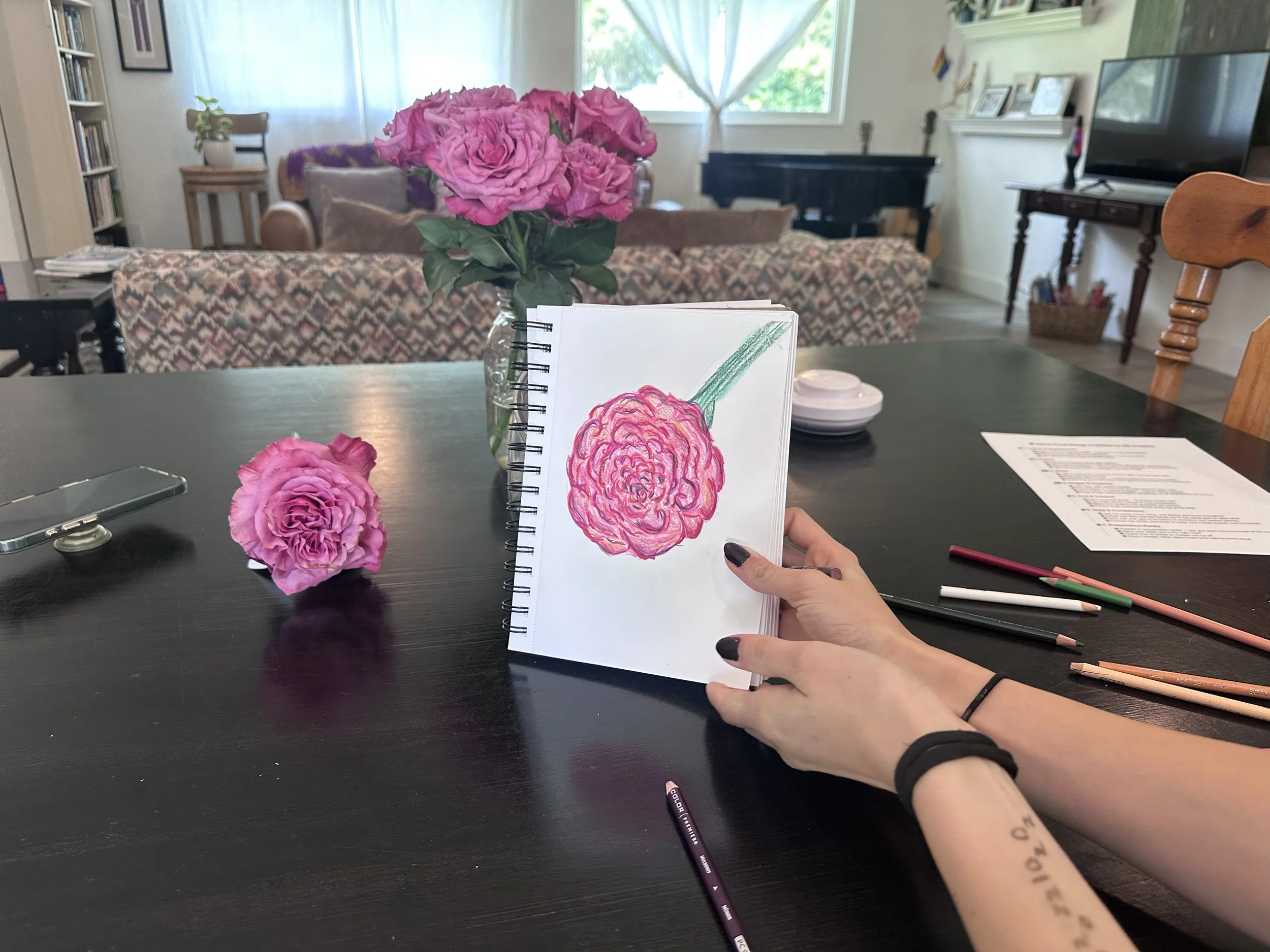Botanical Art Unit Overview
This semester, our students explored the natural world through every lens—scientific, literary, and artistic. As their environmental science and ELA units focused on ecology, sustainability, and our relationship with nature, our art studio became a living extension of that conversation. In our eight-week Botanical Art unit, students learned to see plants not just as background scenery but as complex, living subjects. Through the careful observation and techniques of both past and contemporary botanical artists—many of them pioneering women—students discovered how art can deepen scientific understanding and give voice to the quiet beauty of the environment we study.
Skill-Building Foundations
Observation & Line Work
– Blind contour drawings of leaves, flowers, and seed pods
– Continuous line drawings to loosen up
– Negative space exercises (drawing the space around a plant instead of the plant itself)Detail & Accuracy
– Graphite shading studies of textures (bark, petals, stems, thorns)
– Botanical dissection drawings (draw a flower whole, then dissect and draw each part)Color Work
– Watercolor washes for leaves in different stages (spring green → autumn brown)
– Mixing a full gradient of greens using only blue + yellow + red (no premixed greens)
– Study of translucency in petals with layered watercolorComposition & Design
– Herbarium-inspired pressed plant + drawing pairings
– Symmetry vs. asymmetry in floral compositions
– Create a scientific plate (with notes/labels) vs. a purely aesthetic art piece
Project Ideas
Leaf Library – Each student selects one species of leaf to study in depth: line drawings, texture shading, watercolor rendering, and a final polished piece.
Seasonal Changes – Document a single plant through the seasons (collected photos/sketches → final series).
Microscopic World – Use magnifying glasses or digital microscope images to create “zoomed in” studies of plant structures.
Botanical Portraits – Create a composition where a flower or plant is the “subject” like a human portrait, emphasizing personality/character.
Mixed Media Herbarium – Combine pressed plants, scientific notes, and painted illustrations into a final journal or portfolio.
Historical Recreation – Recreate a page in the style of a chosen botanical illustrator (students pick an artist to emulate).
Contemporary Botanical Art – Encourage students to design a modern botanical piece that blends realism with abstraction, graphic design, or collage.
Artists to Study
Historical Botanical Artists
Maria Sibylla Merian (1647–1717) – Pioneering illustrator of plants and insects, traveled to Suriname to document tropical species.
Elizabeth Blackwell (1707–1758) – Created A Curious Herbal to fund her husband’s debts; one of the first major women-authored botanical works.
Anne Pratt (1806–1893) – Made botanical illustration more accessible to the public in Victorian England.
Marianne North (1830–1890) – Traveled the world painting exotic plants in their natural habitats (unique in her time).
Modern & Contemporary Botanical Artists
Margaret Mee (1909–1988) – Known for Amazonian plant paintings, conservation-focused.
Katie Scott (b. 1988) – Illustrator of Botanicum; blends scientific accuracy with a whimsical style.
Lilian Snelling (1879–1972) – Illustrated thousands of plant species for Royal Botanic Gardens, Kew.
Rosie Sanders (b. 1944) – Contemporary watercolorist known for large-scale, almost hyperrealistic floral paintings.
Other Influential Artists
Pierre-Joseph Redouté (1759–1840) – “Raphael of flowers,” court painter to Marie Antoinette and Josephine Bonaparte.
Ernst Haeckel (1834–1919) – While more zoological, his Art Forms in Nature influenced botanical art’s stylization.
Course Outline
Week 1: Introduction to Botanical Art
Skills: Observation drawing, contour lines, sketchbook setup
Exercises: Blind contour of leaves and flowers; continuous line sketches
Artist Focus: Maria Sibylla Merian – plants + insects, science + art connection
Mini Project: Create a “specimen page” of a simple plant (sketch + notes + first attempt at detail)
Week 2: Structure & Form
Skills: Breaking plants into shapes, negative space, proportion
Exercises: Draw a plant whole, then dissect into parts (flower, leaf, stem)
Artist Focus: Elizabeth Blackwell – early female herbal illustrator
Project: Scientific-style plate of a flower (linework, labeled parts)
Week 3: Shading & Texture
Skills: Value scales, graphite shading for texture (smooth petals vs rough bark)
Exercises: Texture swatches (leaf veins, bark, seeds, moss)
Artist Focus: Anne Pratt – Victorian illustrations with clarity and accuracy
Project: “Leaf Library” page – three leaves rendered in graphite, with notes
Week 4: Color in Botanical Art
Skills: Watercolor washes, layering, mixing natural greens and petal colors
Exercises: Practice mixing 10 shades of green; paint translucent petals
Artist Focus: Pierre-Joseph Redouté – master of watercolor florals
Project: Finalize one botanical study in watercolor (single leaf/flower)
Week 5: Composition & Creativity
Skills: Designing with plants, balance, symmetry vs asymmetry
Exercises: Sketch 3 thumbnail layouts for a floral arrangement or plant portrait
Artist Focus: Marianne North – traveled and painted plants in their habitats
Project: Botanical “portrait” of a chosen plant, with composition focus
Week 6: Modern Botanical Voices
Skills: Combining accuracy with personal style; experimenting with scale
Exercises: Large-scale flower study (zoom in on one bloom or petal section)
Artist Focus: Rosie Sanders (hyperrealistic florals) + Katie Scott (Botanicum, stylized illustration)
Project: Contemporary botanical piece – large scale, bold or stylized
Week 7: Mixed Media & Herbarium Work
Skills: Integrating text, pressed plants, notes, and illustration
Exercises: Press leaves/flowers and design a journal page with them
Artist Focus: Margaret Mee – art + conservation in the Amazon
Project: Mixed media herbarium spread (pressed plant + drawing + notes)


